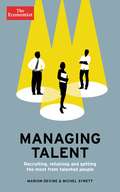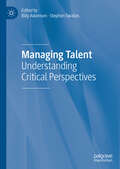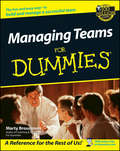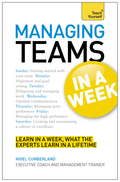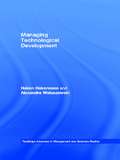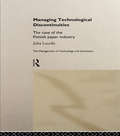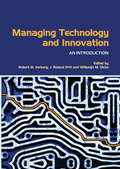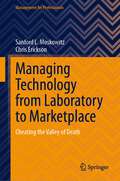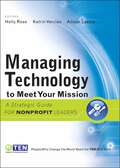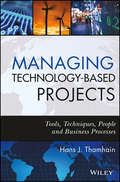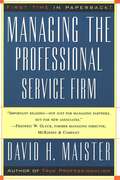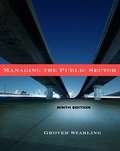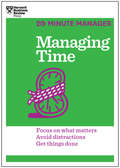- Table View
- List View
Managing Talent: Maximizing the Value of IT Talent
by Robert D. Austin Richard L. Nolan Shannon O'Donnell"The Adventures of an IT Leader" invites readers to "walk in the shoes" of Jim Barton, the new CIO of the fictional IVK Corporation, as he spends a difficult year learning effective information technology leadership, sidestepping the pitfalls that make the CIO job the most volatile, high-turnover job in the business. In this chapter, Barton is confronted with some of the challenges inherent in managing top IT talent. An unproductive but valuable employee highlights the necessity of assessing his team's key skills and contributors. This chapter is excerpted from "The Adventures of an IT Leader."
Managing Talent: Recruiting, Retaining, and Getting the Most from Talented People (Economist Books)
by The Economist Marion Devine Michel SyrettSurvey after survey confirms how the success of businesses has become increasingly dependent on the ability and skills of their staff. And because talented workers are in short supply, the hunt for people of unusual ability will continue in earnest. Hiring such people is the relatively easy part; what really matters is to keep them engaged so that they don't move on, and to get the best out of them while they work for you.Drawing on original research, including interviews with senior executives in human resources, recruiters and headhunters, and people considered "talented" within their organizations, this book outlines the way in which companies such as Ford, Goldman Sachs, Cisco, Diageo, Tesco, General Electric and HSBC are facing the challenge of recruiting and developing the talent they need.This book will also boost readers' own career prospects with practical ideas on how to change their organization's perception of their potential.
Managing Talent: Understanding Critical Perspectives
by Billy Adamsen Stephen SwailesThis edited collection offers a critical appreciation of talent management in contrast to the extensive literature adopting mainstream approaches to the topic. The authors explore fundamental questions in the field to better understand why managing talent seems so attractive as a management practice, the meaning of talent, and how talent is recognised in organisations. The mix of conceptual and empirical chapters in the book teases out some critical perspectives that will provoke thought and reflection among practitioners and stimulate ideas for new research topics and approaches. The diverse contributions presented in this book will undoubtedly be of use to academics, practitioners and postgraduate students of human resource management.
Managing Teams (Pocket Mentor)
by Harvard Business Review<p>Leading teams is an essential skill every manager must possess. To do it effectively, you must know how to instill commitment in your team, improve communication among group members, and diagnose common problems that can derail a team. In this book, you'll find valuable advice and proven strategies for managing teams, including how to: <p> <li>Diagnose common problems that can impede team progress <li>Take corrective measures to remove team problems and improve performance <li>Resolve team conflicts <li>Promote interdependence within teams</li> </p>
Managing Teams For Dummies (For Dummies Ser.)
by Marty BrounsteinIn the ever-changing world of work, the idea of spending some or all of your time working in teams is becoming more and more common. From solving problems, to tackling projects, to providing organizational leadership, the roles and importance of teams continue to grow. Leading a team is no easy job, but when a team gels, they can far outperform traditional work groups. Managing Teams For Dummies is for anyone who has been asked to take on the role of team leader. This book can help you manage your team, whether you’re a senior manager or worker who doesn’t have supervisory responsibilities, but has become the point person on a specific project. Managing Teams For Dummies can help you build and lead high-performing teams. Packed with tips on setting and reaching goals, resolving conflicts, leading teams through change, and providing team members with the skills to work together productively, this book will help you keep any team you mange focused and efficient. Managing Teams For Dummies will also: Take you beyond the conceptual idea of teams and provide practical advice for developing groups that become winning teams Describe the type of leadership needed to guide teams successfully and prepare you for challenges that arise Reveal the three cornerstones’ model for developing team success and provide how-to strategies to make them happen Discuss the types of teams that are growing in popularity, namely self-directed teams, project teams, and task teams Teams make it possible to bring together the variety of skills, perspectives, and talents that you need in the contemporary workplace. With Managing Teams For Dummies you can make sure your team performs to the best of its ability and while trying to achieve its goal.
Managing Teams in a Week: Teach Yourself
by Nigel CumberlandManaging teams requires very different skills than managing individuals, processes orprojects. Management expert Nigel Cumberland will show you how to hit the ground running, identify goals for your team, fill your team with the right members, and help your team reach its potential so that it is more than just the sum of its parts.Sunday: Getting started with a teamMonday: Aligning and goal-setting Tuesday: Communication and processes within a teamWednesday: Managing poor performance or difficult team membersThursday: Delegating and managing work within a teamFriday: Growing the team through training and developmentSaturday: Succession planning in the team
Managing Teams: Forming a Team that Makes a Difference
by Richard LueckeIndividuals are the source of most innovative ideas, but teams of people working together are an organization's best instruments for turning those ideas into marketable products and services. You, as a manager, must learn how to act in this setting--where you cannot be the boss--finding a collaborative way to contribute and support your colleagues. This chapter teaches you that skill.
Managing Technological Development (Routledge Advances in Management and Business Studies #Vol. 22)
by Alexandra Waluszewski Hakan HakanssonIn this book, the story of how IKEA and its paper producers struggled to solve the problem of creating environmentally friendly paper constitutes the foundation of a discussion of technological development. Through a detailed analysis of the case-study, the authors demonstrate the necessity of including social, technological and economical factors when dealing with such issues.Focusing on the interactive aspects of commercial and technological development, they examine how new solutions are developed and shaped in relation to the different companies and organizations involved. They investigate resources in terms of how they are related and built into other resources through historical and contemporary interaction processes. Their overall emphasis is on dealing with the issue of how different, closely and distantly related companies and organizations are affected when resources are developed.
Managing Technological Discontinuities: The Case of the Finnish Paper Industry
by Juha LaurilaUsually firms introduce new technology in an incremental way, wisely seeking to minimise the adverse effects which business and employees might face. However, this is not always the case. Sometimes technological discontinuities occur when radically different technological systems and working practices are implemented, with the possibility of widespread disruption and conflict. This book looks at this topical issue through the experiences of the international giants of the Finnish paper industry - an industry at the cutting edge of fundamental technological innovation.
Managing Technology Entrepreneurship and Innovation
by J. Roland Ortt Paul Trott Dap Hartmann Patrick van der Duin Victor ScholtenManaging Technology Entrepreneurship and Innovation is the first textbook for non-business based entrepreneurship courses, focussed on students with a background in science and technology. Its comprehensive, rigorous and yet accessible approach originates from the authors’ considerable experience mentoring students as they turn their technological ideas into real-life business ventures. . The text is separated into three parts providing a roadmap for successful entrepreneurial projects: Part I focusses on how to create your venture, turning technology into businesses and how to link together entrepreneurship and innovation Part II shows you how to grow your venture and make it profitable, looking at the early development of academic spin-outs and how to adapt your technology to the customers’ needs. Part III takes you through the day-to-day running on your business; whether to adopt a contingency or contextual approach, how to develop new products and services and alternative options for growth. With a wide range of practical steps, lists of things to consider and guidelines on how to turn your technology based ideas into a successful business, this text will be essential for all non-business students who need to understand entrepreneurship, management and innovation. It will also prove a useful introduction to all Masters-level students taking these subjects in business schools.
Managing Technology Transition in Saudi Arabia: Residential Solar Photovoltaic Systems Development
by Khalid A. AlrashoudThis book presents a comprehensive overview of the adoption of small-scale residential solar photovoltaic systems (RSPSs) in Saudi Arabia. Focusing on the current technological development of RSPSs, it discusses elements of socio-technical governance theories and energy policy analysis. It also identifies the critical factors that affect Saudi residents’ decisions to adopt this new technology and analyzes broader energy systems on a state level by investigating factors that shape RSPSs integration policies. This multi-faceted, interdisciplinary book paves the way for an integrated transition management policy design model to stimulate RSPSs adoption rates. Given its scope, it is a valuable resource for readers seeking an in-depth and up-to-date integrated overview of the ever-expanding theoretical and quantitative fields of socio-technical transitions and the transition to sustainability.
Managing Technology and Innovation: An Introduction
by Robert Verburg J. Roland Ortt Willemijn M. DickeModern technology and innovation are vital to the success of all companies, be they hi-tech firms or companies seemingly unaffected by technology and innovation; whether established firms or business start-ups. This book focuses on understanding technology as a corporate resource, covering product development, design of systems and the managerial aspects of new and high technology. Topics investigated include: the internal organization of high technology firms the management of technology in society managing innovation dilemmas and strategies. The wide-ranging experience of the teachers and experts contributing to this book has resulted in an integrated, multi-disciplinary, textbook that provides an introductory overview to managing technology and innovation in the twenty-first century. This text is essential reading for students of business and engineering concerned with technology and innovation management.
Managing Technology from Laboratory to Marketplace: Cheating the Valley of Death (Management for Professionals)
by Sanford L. Moskowitz Chris EricksonManaging Technology from Laboratory to Marketplace outlines the process of getting innovative research out of the laboratory and into the market, a path which is often fraught with challenges. Many research projects meet their end as they attempt to cross this so-called “valley of death"--the period between the research phase of a project and the point when the new product or process emerging from that research becomes commercialized and enters the market. Firstly, this book aims to better understand how and why projects succeed in entering the market while others falter. Second, it uses these insights to guide researchers to optimize their chances of successfully making that transition, and finding their place in the market. The book primarily uses case studies from the field of advanced materials, but can be used by any researcher making the transition from laboratory to marketplace.
Managing Technology to Meet Your Mission: A Strategic Guide for Nonprofit Leaders
by Holly Ross Alison Levine Katrin VerclasManaging Technology to Meet Your Mission is a practical resource that will help nonprofit professionals make smart, strategic decisions about technology. The book shows how to effectively manage technology and offers practical advice for decision makers and staff alike who often have little or no experience with technology. With contributions from the top experts in the nonprofit technology field, this must-have guide addresses technology planning and people. It includes the tools you need to get the work done, and the knowledge that will help you communicate better, evaluate technology investments, raise money, and more. Written in nontechnical language the book covers a broad spectrum of topics including: Achieving IT Alignment with Your Mission Steve Heye, YMCA of the USA Managing Technology Change Dahna Goldstein, PhilanTech Measuring the Return on Investment of Technology Beth Kanter, trainer, blogger and consultant IT Planning and Prioritizing Peter Campbell, Earthjustice Finding and Keeping the Right PeopleJames L. Weinberg and Cassie Scarano, Commongood Careers Budgeting For and Funding Technology Scott McCallum and Keith R. Thode, Aidmatrix Foundation Introduction to IT and Systems Kevin Lo and Willow Cook, TechSoup Global Where Are Your Stakeholders, and What Are They Doing Online? Michael Cervino, Beaconfire Consulting Effective Online CommunicationsJohn Kenyon, nonprofit technology strategist Effective Online Fundraising Madeline Stanionis, Watershed The Future if IT in NonprofitsEdward Granger-Happ, Save the Children Praise for Managing Technology to Meet Your Mission "This invaluable guide for nonprofit leaders proves that nonprofit organizations can and should embrace technology, rather than being scared of or intimidated by it!" --Kristie Ferketich, senior strategist, Google Grants, Google Inc. "NTEN's Managing Technology to Meet Your Mission can help leaders craft a technology strategy that makes sense and builds ROI while also providing inspiration for their staff and supporters!" --Jonathon D. Colman, associate director and web evangelista, digital marketing, The Nature Conservancy "This book shows what NTEN does best: Bring together a wide range of voices to provide practical technology strategies and know-how to help nonprofits more efficiently and effectively move their own missions forward." --Marnie Webb, TechSoup Global
Managing Technology-Based Projects
by Hans J. ThamhainA GUIDE TO EFFECTIVE PROJECT MANAGEMENT IN TECHNOLOGY-BASED FIRMSUsed effectively, project management can increase a firm's market share, product quality, and customer satisfaction. Though technology-based companies place themselves at a competitive disadvantage if they neglect this strategic tool, many overlook project management's benefits because they see themselves as continuously adapting organizations. In reality, this role makes project management even more vital.Managing Technology-Based Projects imparts the latest approaches and tools essential to lead a successful technology-based project. It outlines the practical integration of project management with four key areas: strategic alignment of projects within the enterprise, the project management process and its organizational support system, invaluable tools and techniques, and the individual and group leadership within a project's organization. Complete with examples of industrial applications, the book includes:Methods for defining key performance indicators and assessing project management process effectivenessSuggestions for fine-tuning and continuous improvementPractical case scenarios, discussion topics, end-of-chapter reviews, and exercisesAttention to project management as it applies to a globalized businessNo one in a managerial role should be without Thamhain's expert advice. This guidebook is your road map to successfully incorporating enterprise project management into technology-based work.
Managing Television News: A Handbook for Ethical and Effective Producing (Routledge Communication Series)
by B. William Silcock Don Heider Mary T. RogusManaging Television News provides a practical introduction to the television news producer, one of the most significant and influential roles in a newscast. Recognizing the need for formal training in this key role, authors B. William Silcock, Don Heider, and Mary T. Rogus have combined their expertise and experience to shape this essential resource on the responsibilities, demands, and rewards of the news producer position. Their book provides a strategic approach to producing newscasts and serves as an in-depth guide to creating quality, audience-friendly newscasts working within the realistic limitations of most newsrooms. It helps the student and the professional producer sort through the various deadline-driven challenges of creating a 30-minute newscast. Filled with real-world examples and advice from news directors, producers, and anchors currently in the business, and photographs illustrating the varied perspectives in the position, Managing Television News provides critical skill sets to help resolve ethical dilemmas, as well as keen and fresh insights on how to win the ratings without compromising news quality. Career concerns are also addressed. This resource is a pioneering book for the professional television newsroom and the individual reader interested in starting or expanding a producing career. It is an excellent text for the college classroom, as its structure fits neatly into a semester schedule, and it is a must-have resource for both seasoned and novice producers, as well as students in broadcast news.
Managing The Professional Service Firm
by David H. MaisterFor the first time in paperback, international expert and consultant David Maister offers a brilliant and accessible guide to every management issue at play in professional firms. Professional firms differ from other business enterprises in two distinct ways: first, they provide highly customized services and thus cannot apply many of the management principles developed for product-based industries. Second, professional services are highly personalized, involving the skills of individuals. Such firms must therefore compete not only for clients but also for talented professionals. Drawing on more than ten years of research and consulting to these unique and creative companies, David Maister explores issues ranging from marketing and business development to multinational strategies, human resources policies to profit improvement, strategic planning to effective leadership. While these issues can be complex. Maister simplifies them by recognizing that "every professional service firm in the world, regardless of size, specific profession, or country of operation, has the same mission statement: outstanding service to clients, satisfying careers for its people, and financial success for its owners."
Managing The Professional Service Firm
by David H. MaisterProfessional service firms differ from other business enterprises in two distinct ways: first they provide highly customised services thus cannot apply many of the management principles developed for product-based industries. Second, professional services are highly personalised, involving the skills of individuals. Such firms must therefore compete not only for clients but also for talented professionals.Drawing on more than ten years of research and consulting to these unique and creative companies, David Maister explores issues ranging from marketing and business development to multinational strategies, human resources policies to profit improvement, strategic planning to effective leadership. While these issues can be complex, Maister simplifies them by recognising that 'every professional service firm in the world, regardless of size, specific profession, or country of operation, has the same mission statement: outstanding service to clients, satisfying careers for its people and financial success for its owners.'
Managing The Professional Service Firm
by David H. MaisterProfessional service firms differ from other business enterprises in two distinct ways: first they provide highly customised services thus cannot apply many of the management principles developed for product-based industries. Second, professional services are highly personalised, involving the skills of individuals. Such firms must therefore compete not only for clients but also for talented professionals. Drawing on more than ten years of research and consulting to these unique and creative companies, David Maister explores issues ranging from marketing and business development to multinational strategies, human resources policies to profit improvement, strategic planning to effective leadership. While these issues can be complex, Maister simplifies them by recognising that 'every professional service firm in the world, regardless of size, specific profession, or country of operation, has the same mission statement: outstanding service to clients, satisfying careers for its people and financial success for its owners.'
Managing The Professional Service Firm
by David H. MaisterProfessional service firms differ from other business enterprises in two distinct ways: first they provide highly customised services thus cannot apply many of the management principles developed for product-based industries. Second, professional services are highly personalised, involving the skills of individuals. Such firms must therefore compete not only for clients but also for talented professionals. Drawing on more than ten years of research and consulting to these unique and creative companies, David Maister explores issues ranging from marketing and business development to multinational strategies, human resources policies to profit improvement, strategic planning to effective leadership. While these issues can be complex, Maister simplifies them by recognising that 'every professional service firm in the world, regardless of size, specific profession, or country of operation, has the same mission statement: outstanding service to clients, satisfying careers for its people and financial success for its owners.'
Managing The Professional Service Firm
by David H. MaisterInternational expert and consultant David Maister offers a brilliant and accessible guide to every management issue at play in professional firms.Professional firms differ from other business enterprises in two distinct ways: first, they provide highly customized services and thus cannot apply many of the management principles developed for product-based industries. Second, professional services are highly personalized, involving the skills of individuals. Such firms must therefore compete not only for clients but also for talented professionals. Drawing on more than ten years of research and consulting to these unique and creative companies, David Maister explores issues ranging from marketing and business development to multinational strategies, human resources policies to profit improvement, strategic planning to effective leadership. While these issues can be complex, Maister simplifies them by recognizing that “every professional service firm in the world, regardless of size, specific profession, or country of operation, has the same mission statement: outstanding service to clients, satisfying careers for its people, and financial success for its owners.”
Managing The Public Sector, 9th Edition
by Grover StarlingCombining the most current public management thinking and research with examples of how public executives and organizations apply these ideas, MANAGING THE PUBLIC SECTOR is a comprehensive introduction to the field of public management. The Ninth Edition continues to engage the student's intellect by providing more than just the basic foundations of management; it places the application of management in the context of the public sector and tries to capture the excitement and challenge of the field.
Managing Time (20-Minute Manager Series)
by Harvard Business ReviewDoes it seem like you never have enough time to get everything done? Keeping on top of your tasks, deadlines, and work schedule can be daunting. Managing Time quickly walks you through the basics. You'll learn to: Assess how you spend your time now Prioritize your tasks Plan the right time to work on each one Avoid procrastination and interruptionsAbout HBR's 20-Minute Manager Series:Don't have much time? Get up to speed fast on the most essential business skills with HBR's 20-Minute Manager series. Whether you need a crash course or a brief refresher, each book in the series is a concise, practical primer that will help you brush up on a key management topic.Advice you can quickly read and apply, for ambitious professionals and aspiring executives-from the most trusted source in business. Also available as an ebook.
Managing Time (20-Minute Manager Series)
by Harvard Business ReviewBoost your productivity with these essential tips.About HBR's 20-Minute Manager Series:Don't have much time? Get up to speed fast on the most essential business skills with HBR's 20-Minute Manager series. Whether you need a crash course or a brief refresher, each book in the series is a concise, practical primer that will help you brush up on a key management topic.Advice you can quickly read and apply, for ambitious professionals and aspiring executives-from the most trusted source in business. Also available as an ebook.
Managing Time (20-Minute Manager Series)
by Harvard Business ReviewDoes it seem like you never have enough time to get everything done? Keeping on top of your tasks, deadlines, and work schedule can be daunting. Managing Time quickly walks you through the basics. You'll learn to: Assess how you spend your time now Prioritize your tasks Plan the right time to work on each one Avoid procrastination and interruptionsAbout HBR's 20-Minute Manager Series:Don't have much time? Get up to speed fast on the most essential business skills with HBR's 20-Minute Manager series. Whether you need a crash course or a brief refresher, each book in the series is a concise, practical primer that will help you brush up on a key management topic.Advice you can quickly read and apply, for ambitious professionals and aspiring executives-from the most trusted source in business. Also available as an ebook.

